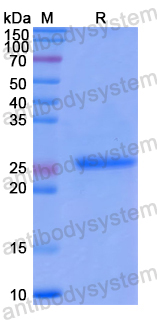Catalog No.
YHJ45401
Expression system
E. coli
Species
Homo sapiens (Human)
Protein length
His110-Pro317
Predicted molecular weight
26.56 kDa
Nature
Recombinant
Endotoxin level
Please contact with the lab for this information.
Purity
>90% as determined by SDS-PAGE.
Accession
Q99645
Applications
ELISA, Immunogen, SDS-PAGE, WB, Bioactivity testing in progress
Form
Lyophilized
Storage buffer
Lyophilized from a solution in PBS pH 7.4, 0.02% NLS, 1mM EDTA, 4% Trehalose, 1% Mannitol.
Reconstitution
Reconstitute in sterile water for a stock solution. A copy of datasheet will be provided with the products, please refer to it for details.
Shipping
In general, proteins are provided as lyophilized powder/frozen liquid. They are shipped out with dry ice/blue ice unless customers require otherwise.
Stability and Storage
Use a manual defrost freezer and avoid repeated freeze thaw cycles. Store at 2 to 8°C for frequent use. Store at -20 to -80°C for twelve months from the date of receipt.
Alternative Names
DSPG3, SLRR3B, Proteoglycan-Lb, Small chondroitin/dermatan sulfate proteoglycan, Epiphycan, EPYC, PG-Lb, PGLB, Dermatan sulfate proteoglycan 3
Unveiling promising breast cancer biomarkers: an integrative approach combining bioinformatics analysis and experimental verification., PMID:38291367
EPYC functions as a novel prognostic biomarker for pancreatic cancer., PMID:38184732
A single dietary factor, daily consumption of a fermented beverage, can modulate the gut bacteria and fecal metabolites within the same ethnic community., PMID:37882544
UNRES-GPU for physics-based coarse-grained simulations of protein systems at biological time- and size-scales., PMID:37338530
Unravelling the limb regeneration mechanisms of Polypedates maculatus, a sub-tropical frog, by transcriptomics., PMID:36927452
KLF9 and EPYC acting as feature genes for osteoarthritis and their association with immune infiltration., PMID:35902862
Single-Cell RNA-Seq Analysis of Cells from Degenerating and Non-Degenerating Intervertebral Discs from the Same Individual Reveals New Biomarkers for Intervertebral Disc Degeneration., PMID:35409356
Epiphycan Predicts Poor Outcomes and Promotes Metastasis in Ovarian Cancer., PMID:34888227
Database Mining of Genes of Prognostic Value for the Prostate Adenocarcinoma Microenvironment Using the Cancer Gene Atlas., PMID:32509861
Orchestration of algal metabolism by protein disorder., PMID:31408624
Genes associated with bowel metastases in ovarian cancer., PMID:31204077
Posterior amorphous corneal dystrophy in a patient with 12q21.33 deletion., PMID:30058938
Confirmation and refinement of the heterozygous deletion of the small leucine-rich proteoglycans associated with posterior amorphous corneal dystrophy., PMID:29671669
In vivo effect of opticin deficiency in cartilage in a surgically induced mouse model of osteoarthritis., PMID:29323130
Retrograde inhibition by a specific subset of interpeduncular α5 nicotinic neurons regulates nicotine preference., PMID:29158387
Epiphycan is specifically expressed in cochlear supporting cells and is necessary for normal hearing., PMID:28864419
New genes associated with rheumatoid arthritis identified by gene expression profiling., PMID:28371410
Mesenchymal precursor cells maintain the differentiation and proliferation potentials of breast epithelial cells., PMID:24916766
Posterior amorphous corneal dystrophy is associated with a deletion of small leucine-rich proteoglycans on chromosome 12., PMID:24759697
Evaluation of proteoglycan gene polymorphisms as risk factors in the genetic susceptibility to high myopia., PMID:21743019
Linkage of posterior amorphous corneal dystrophy to chromosome 12q21.33 and exclusion of coding region mutations in KERA, LUM, DCN, and EPYC., PMID:20357198
An evaluation of OPTC and EPYC as candidate genes for high myopia., PMID:19844586
The association of haplotype at the lumican gene with high myopia susceptibility in Taiwanese patients., PMID:19616852
Autosomal dominant cornea plana is not associated with pathogenic mutations in DCN, DSPG3, FOXC1, KERA, LUM, or PITX2., PMID:17558846
The association of single nucleotide polymorphisms in the 5'-regulatory region of the lumican gene with susceptibility to high myopia in Taiwan., PMID:16902402
Molecular cloning and expression of two small leucine-rich proteoglycan (SLRP) genes, dspg3l and optcl, in zebrafish., PMID:16458084
Repeated sound stress enhances inflammatory pain in the rat., PMID:15936144
Isolation of a novel iris-specific and leucine-rich repeat protein (oculoglycan) using differential selection., PMID:10892843
Super-motifs and evolution of tandem leucine-rich repeats within the small proteoglycans--biglycan, decorin, lumican, fibromodulin, PRELP, keratocan, osteoadherin, epiphycan, and osteoglycin., PMID:10656267
Identification in vitreous and molecular cloning of opticin, a novel member of the family of leucine-rich repeat proteins of the extracellular matrix., PMID:10636917
Expression and localization of PG-Lb/epiphycan during mouse development., PMID:10633869
Genomic characterization of human DSPG3., PMID:10330124
Decorin, epiphycan, and lumican genes are closely linked on murine Chromosome 10 and are deleted in lethal steel mutants., PMID:9922406
Occurrence of PG-Lb, a leucine-rich small chondroitin/dermatan sulphate proteoglycan in mammalian epiphyseal cartilage: molecular cloning and sequence analysis of the mouse cDNA., PMID:8836137
Molecular cloning of the mouse osteoglycin-encoding gene., PMID:7607548

